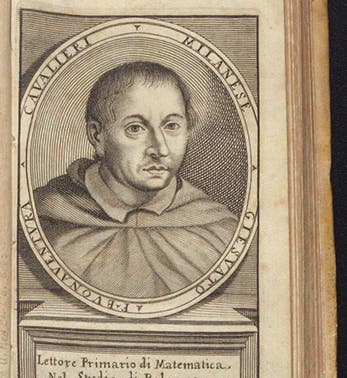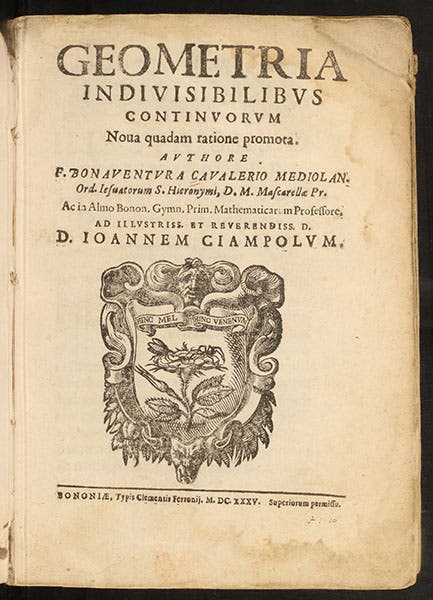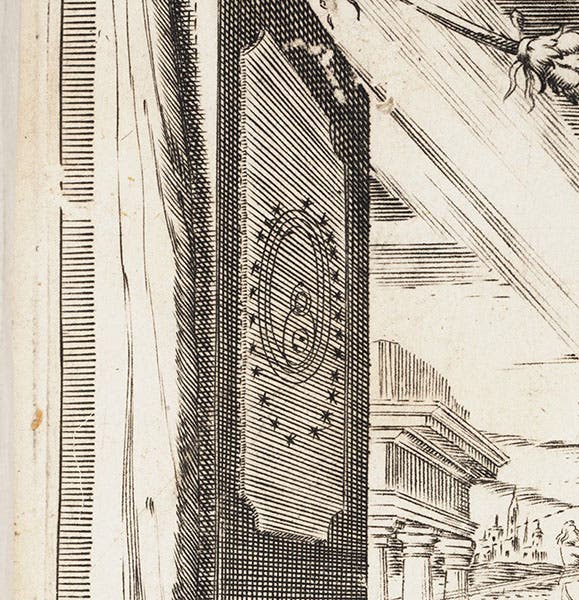Scientist of the Day - Bonaventura Cavalieri
Bonaventura Cavalieri, an Italian mathematician and a member of the Jesuate order, died on Nov. 30. 1647; he was born sometime in 1598, making him only 47 or so at the time of his death. He was born in Milan, and studied mathematics under Benedetto Castelli at Pisa, whom he eventually replaced. It was probably through Castelli that Cavalieri came to know Galileo (Galileo wrote a famous Letter to Castelli in 1613 that inaugurated the "Galileo affair," culminating in Galileo's trial in 1633 and the banning of Copernicanism). Cavalieri spent much of the 1620s trying to get a better teaching position, finally securing the chair of mathematics at Bologna in 1629, through – it is thought – Galileo's intervention on his behalf. And we should reiterate that the Jesuates (also designated as Jesuati or Gesuati) should not be confused with the Jesuits, the Society of Jesus, which was an entirely distinct order. In fact, the Jesuits and Jesuates were often at odds, as we mentioned last month in our post on Stefano degli Angeli, another Jesuate, who just happened to be the pupil of Cavalieri.
Cavalieri is best known for developing the theory of indivisibles, whereby a line is considered to be made up of an infinite number of non-dimensional points (the indivisibles), and a plane of an infinite number on one-dimensional lines (also indivisibles). Cavalieri's indivisibles are considered important by historians of mathematics for giving rise to the infinitesimals of John Wallis, which in turn led to the development of differential and integral calculus by Isaac Newton and Gottfried Leibniz, which makes Cavalieri at least a midwife, if not a direct parent, to the birth of calculus.
However, Cavalieri’s greatest contribution to the history of science might have been his role in keeping Galileo going when Galileo's world was falling apart in 1634. Galileo had been sentenced to house arrest by the Inquisition in 1633, and his Dialogue on the Two Chief World Systems had been banned. Then in early 1634, Galileo's daughter Suor Maria Celeste, who lived in a convent in Arcetri, died, leaving Galileo nearly inconsolable, and he was ill to boot, afflicted with a hernia, for which the Church would not allow him to seek medical relief in Florence. He might well have never returned to scientific work. But Cavalieri wrote Galileo regularly, urging him to complete his book on mechanics and projectile motion, and asking him questions about indivisibles and how they might be used in Galileo's own work. Cavalieri said he was delaying publishing his own book on indivisibles until Galileo published his. All this amicable badgering seems to have been effective, as Galileo got back to work on his book. Cavalieri published The Geometry of Indivisibles in 1635, and Galileo would complete and publish his Discourse on Two New Sciences in 1638.
Cavalieri's Geometria indivisibilibus, the title page of which we show above (second image), is not an especially dramatic book – it has no engraved title page or portrait, and the only illustrations are simple diagrams. But our copy has a handsome 17th-century limp-vellum binding, which we thought we would show you along with the title page (third image), because I do not recall ever including a photo of a limp-vellum binding in one of these posts.
We have five Cavalieri works in our collections, four published during his lifetime, and one posthumous work, the Sfera astronomica (1690), which contains a portrait (first image). I thought I would include here the engraved title page to Cavalieri’s Trigonometria (1643), because it presents a minor mystery (fourth image). As far as we know, Cavalieri was a full-blooded Copernican, just like Galileo, but on the left side of the arch on the title page, there are two diagrams. The one at the bottom, for which we include a detail (sixth image), depicts the phases of Venus – the fact discovered by Galileo in 1610, that Venus goes through phases just like the Moon, which you can only see with a telescope. Galileo trumpeted the phases of Venus as evidence for the Copernican system, since you would not see these phases if Venus circled the Earth. However, the phases of Venus are also predicted by the geo-heliocentric system of Tycho Brahe (the Tychonic system), a fact that Galileo completely ignored in his Dialogue. Yet just above the diagram of the phases of Venus, on Cavalieri’s title page, is a diagram of the Tychonic system (fifth image). Is this a hint that Cavalieri, like many Catholics, preferred the Tychonic system to the Copernican cosmology? I do not know the answer. That is why it is a mystery.
Cavalieri spent most of his life in Bologna, but if you want to find a statue, you need to go to his birth city of Milan, where they erected one in 1844 in the Accademia di Brera (seventh image).
William B. Ashworth, Jr., Consultant for the History of Science, Linda Hall Library and Associate Professor emeritus, Department of History, University of Missouri-Kansas City. Comments or corrections are welcome; please direct to ashworthw@umkc.edu.













